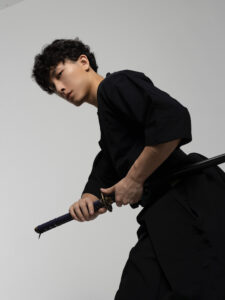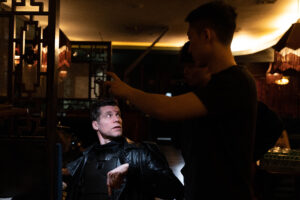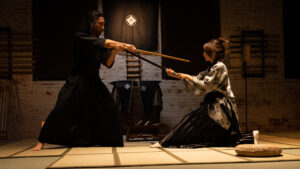Spike Zhao- Actor & Fight Choreographer (Interview)
(Published: 2024/04/24 at 5:03 pm)
Edition Eighty-Two- Week Eighty-Two:
Written by: Mercedes Barreto

What got you into martial arts? What got you into film? Why and how so?
“I fought a lot when I was in middle school. Sometimes, my classmates and I would spontaneously start friendly but full-contact sparring during class breaks, using bare knuckles and avoiding headshots. I wasn’t trained in any forms of combat sports or martial arts by that time but somehow my punches are just naturally fast and swift, and one classmate even gave me the nickname as “Ip Man Zhao” as a joke. Later on I started formally training in various styles of combat sports and martial arts. I’ve trained boxing extensively with the head coach of the Jilin Provincial boxing team, and I’ve also learned martial arts such as Muay Thai and Bajiquan, etc. During my college years in U.S., I continued training in boxing and has been into various competitions. I’ve also continued my journey in learning various styles of martial arts by learning Escrima, Wing Chun, Bagua, Kyokushin Karate, Xingyi, Jeet Kune Do, etc. And I gradually realized my love for martial arts and the urge to turn that passion into my career. Unfortunately there are only so few paths to turn martial arts into a career, and after careful decision, I chose to use it in action acting and fight choreography in films. I believe this is one of the wisest decisions I’ve ever made because it’s a career I can dedicate myself to for my entire life, even as I
age and my body becomes less mobile. I will still carry that knowledge and choreography things that are authentic and beautiful.”

Why do you believe it is important to be accessorized with a martial arts expert when choreographing fight scenes on a film set? Why do people need an expert such as yourself? What do you bring to the table?
“Merely understanding how martial arts work does not equip you to be a fight choreographer. However, I’ve found it hard to believe that many filmmakers don’t realize that understanding how stunts and cinematography work does not necessarily qualify someone to be a fight choreographer either. It is, without a doubt, necessary to have knowledge in combat sports/martial arts, stunt coordinating, and cinematography to be a well-rounded fight choreographer. Yet, I have found it common for many stunt coordinators to underestimate the importance of understanding martial art principles and techniques. I grew up with the influence of Hong Kong action cinema, thus I have a biased personal preference for the aesthetics of action movies. So, I prefer action scenes with long takes, showcasing extensive choreography and realistic stunt work that accurately depicts the impact of every move. I noticed some stunt coordinators, possibly due to a lack of knowledge in a variety of martial art techniques, try to compensate for the beauty of various martial art moves by filling the fight scene with an abundant number of unnecessarily exaggerated and unrealistic stunt falls and smashes. Some filmmakers might defend their approach by claiming that real fights are nothing fancy and are supposed to be ugly and messy, which I do agree with. However, I believe ugly and messy are not the only elements that make a fight scene real. Most of the time, the ugly fight is just purely unattractive instead of capturing the beauty of brutality and violence.

I believe there are definitely different styles of fight choreographers who have specialties of their own. As a fight choreographer who is still exploring and growing at the moment, I strongly feel that I am better at designing fights that involve authentic martial arts movements and techniques yet also emphasize being realistic and showcasing the beauty of brutality. My background in traditional martial arts offers me authentic knowledge in martial art techniques, and my experience in boxing competitions also provides me with a better understanding of timing and distance. I especially love to incorporate martial art moves into contemporary story settings, such as assigning Chinese martial art joint lock techniques to a secret agent or designing a double knife fighting system based on Bagua for a hitman character. I believe those elements add a different touch and flavor to fight scenes, without losing touch with reality.”
Where do you find inspiration, and motivation? Does that apply to your line of work, and how so?
“Fortunately for action filmmaking, there are many sources that offer me inspiration and motivation. I have always loved action film classics such as the John Wick series, The Raid, Ip Man, Kill Zone, etc., and I’ve watched those films countless times, not only for enjoyment but also to learn cutting-edge action filmmaking techniques.
In addition to finding inspiration for fight choreography, I also draw inspiration from many legendary action actors. I watch a lot of the classic works from actors such as Jet Li and Donnie Yen to study their rhythms and styles. I believe I have significantly improved my skills by observing how they move.”

What makes Spike Zhao the best choice for certain action roles on a serious film set?
“I have always believed that people have their specialties in each professional field, and it is always wise to choose the best fit for each position. There are many talented action actors who specialize in various tricking techniques, and there are also people who are experienced in wires and car stunts. I guess in my case, considering my background in combat sports and martial arts, one of my advantages is the ability to demonstrate martial art techniques that are authentic, beautiful, yet fierce and brutal. The reason why Jet Li is the action hero for countless films is not just because he can do a kick. In fact, there are many people who could perform the exact same kick. It’s the way he delivers that kick that makes him stand out from the rest of the crowd. Bruce Lee once said, “I fear not the man who has practiced 10,000 kicks once, but I fear the man who has practiced one kick 10,000 times.” A lot of the time, what matters most is if you can deliver a technique with the subtle details that make it irreplaceably beautiful, rather than knowing how to do a lot of different tricks, but each being mediocre. One important lesson I’ve learned through my journey in action acting is that I should always try to perfect my techniques before trying to handle too many fancy movements.
To ensure that, I am still rigorously practicing and learning every day. Another advantage I have is probably my surgical precision and timing, nurtured through my extensive boxing training. I might be wrong, but I vaguely remember Sammo Hung, the action director behind the famous movie “Ip Man 1 & 2,” once said the most important element for an action actor to have been the precision to hit close enough to the target without making contact. I have always believed that, and throughout my career, I have verified this idea countless times. The action actors who are capable of having this precision are always the ones who elevate the action scenes.”
ManualMagazines.com
This website uses cookies to provide you with the best browsing experience.
